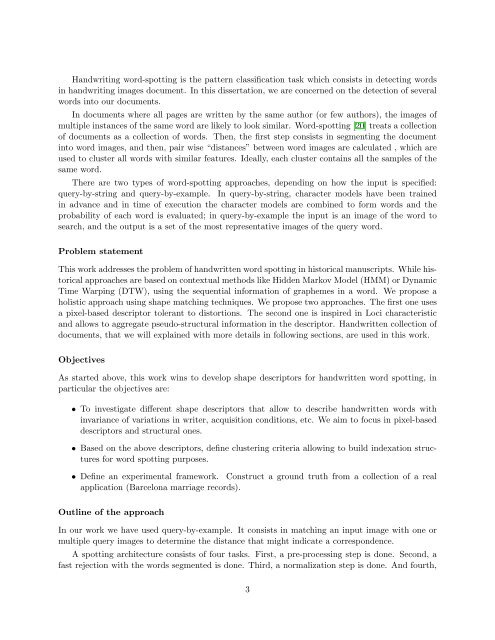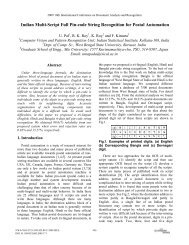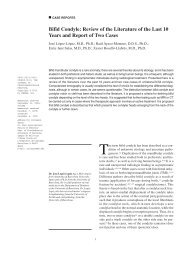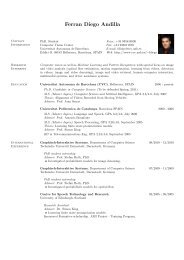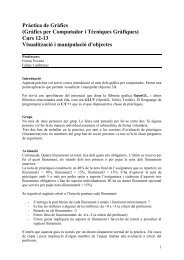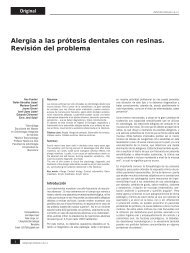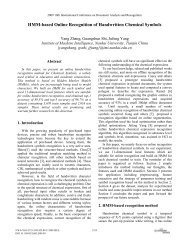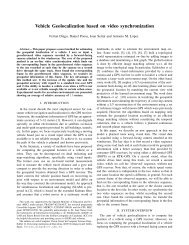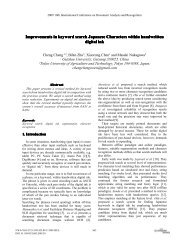Handwritten Word Spotting in Old Manuscript Images using Shape ...
Handwritten Word Spotting in Old Manuscript Images using Shape ...
Handwritten Word Spotting in Old Manuscript Images using Shape ...
Create successful ePaper yourself
Turn your PDF publications into a flip-book with our unique Google optimized e-Paper software.
Handwrit<strong>in</strong>g word-spott<strong>in</strong>g is the pattern classification task which consists <strong>in</strong> detect<strong>in</strong>g words<br />
<strong>in</strong> handwrit<strong>in</strong>g images document. In this dissertation, we are concerned on the detection of several<br />
words <strong>in</strong>to our documents.<br />
In documents where all pages are written by the same author (or few authors), the images of<br />
multiple <strong>in</strong>stances of the same word are likely to look similar. <strong>Word</strong>-spott<strong>in</strong>g [20] treats a collection<br />
of documents as a collection of words. Then, the first step consists <strong>in</strong> segment<strong>in</strong>g the document<br />
<strong>in</strong>to word images, and then, pair wise “distances” between word images are calculated , which are<br />
used to cluster all words with similar features. Ideally, each cluster conta<strong>in</strong>s all the samples of the<br />
same word.<br />
There are two types of word-spott<strong>in</strong>g approaches, depend<strong>in</strong>g on how the <strong>in</strong>put is specified:<br />
query-by-str<strong>in</strong>g and query-by-example. In query-by-str<strong>in</strong>g, character models have been tra<strong>in</strong>ed<br />
<strong>in</strong> advance and <strong>in</strong> time of execution the character models are comb<strong>in</strong>ed to form words and the<br />
probability of each word is evaluated; <strong>in</strong> query-by-example the <strong>in</strong>put is an image of the word to<br />
search, and the output is a set of the most representative images of the query word.<br />
Problem statement<br />
This work addresses the problem of handwritten word spott<strong>in</strong>g <strong>in</strong> historical manuscripts. While historical<br />
approaches are based on contextual methods like Hidden Markov Model (HMM) or Dynamic<br />
Time Warp<strong>in</strong>g (DTW), us<strong>in</strong>g the sequential <strong>in</strong>formation of graphemes <strong>in</strong> a word. We propose a<br />
holistic approach us<strong>in</strong>g shape match<strong>in</strong>g techniques. We propose two approaches. The first one uses<br />
a pixel-based descriptor tolerant to distortions. The second one is <strong>in</strong>spired <strong>in</strong> Loci characteristic<br />
and allows to aggregate pseudo-structural <strong>in</strong>formation <strong>in</strong> the descriptor. <strong>Handwritten</strong> collection of<br />
documents, that we will expla<strong>in</strong>ed with more details <strong>in</strong> follow<strong>in</strong>g sections, are used <strong>in</strong> this work.<br />
Objectives<br />
As started above, this work w<strong>in</strong>s to develop shape descriptors for handwritten word spott<strong>in</strong>g, <strong>in</strong><br />
particular the objectives are:<br />
• To <strong>in</strong>vestigate different shape descriptors that allow to describe handwritten words with<br />
<strong>in</strong>variance of variations <strong>in</strong> writer, acquisition conditions, etc. We aim to focus <strong>in</strong> pixel-based<br />
descriptors and structural ones.<br />
• Based on the above descriptors, def<strong>in</strong>e cluster<strong>in</strong>g criteria allow<strong>in</strong>g to build <strong>in</strong>dexation structures<br />
for word spott<strong>in</strong>g purposes.<br />
• Def<strong>in</strong>e an experimental framework. Construct a ground truth from a collection of a real<br />
application (Barcelona marriage records).<br />
Outl<strong>in</strong>e of the approach<br />
In our work we have used query-by-example. It consists <strong>in</strong> match<strong>in</strong>g an <strong>in</strong>put image with one or<br />
multiple query images to determ<strong>in</strong>e the distance that might <strong>in</strong>dicate a correspondence.<br />
A spott<strong>in</strong>g architecture consists of four tasks. First, a pre-process<strong>in</strong>g step is done. Second, a<br />
fast rejection with the words segmented is done. Third, a normalization step is done. And fourth,<br />
3


